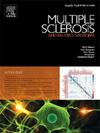Real-world infection risk in multiple sclerosis patients on long-term immunomodulatory treatments
IF 2.9
3区 医学
Q2 CLINICAL NEUROLOGY
引用次数: 0
Abstract
Introduction
Numerous immunomodulatory treatments exist for multiple sclerosis (MS), including those that deplete immune cells (e.g. anti-CD20 medications), relocate immune cells (e.g. natalizumab, S1P modulators), or modulate immune subsets (e.g. fumarates). All disease-modifying treatments (DMTs) can increase infection risk which could worsen with prolonged use.
Methods
This is a retrospective, single-center, observational cohort study. We analyzed medical records of adult people with MS who took natalizumab, S1P modulators, fumarates or anti-CD20 medications for over two years between January 2013 and April 2021 at Yale. We identified severe infections (requiring hospitalization) and mild infections (identified through outpatient antibiotic prescriptions or chart reference to “infection”). We used a zero-inflated negative binomial regression to assess the effects of DMT use, treatment duration, and patient characteristics on infection likelihood and frequency, while controlling for biologic sex, body mass index, ambulatory status, Charlson Comorbidity Index (CCI), diagnosis, disease modifying therapy and treatment duration.
Results
104 patients received natalizumab, 61 fumarates, 17 S1P modulators and 291 anti-CD20 medications, with significant baseline differences in age, diagnosis, duration of DMT use, and CCI. Mild infection rates did not differ across DMTs, but severe infections were more common in patients on fumarates. Patients with longer DMT duration or requiring a walking aid had higher mild infection rates, while those with progressive MS or on long-term fumarates had higher severe infection rates, even after controlling for other variables.
Discussion
This study demonstrates how real-life practice patterns, patient factors and DMT choice can influence infection rates, differing from randomized trial patterns. Natalizumab appears safe over extended use, while fumarates were linked to more severe infections, potentially due to the clinical selection of patients with poorer baseline health. The duration of DMT use may predict mild infection rates.
长期免疫调节治疗的多发性硬化症患者的真实感染风险
目前有许多针对多发性硬化症(MS)的免疫调节疗法,包括消耗免疫细胞(如抗cd20药物)、重新安置免疫细胞(如natalizumab、S1P调节剂)或调节免疫亚群(如富马酸盐)。所有疾病改善治疗(dmt)都可能增加感染风险,并可能随着长期使用而恶化。方法:这是一项回顾性、单中心、观察队列研究。我们分析了耶鲁大学2013年1月至2021年4月期间服用natalizumab、S1P调节剂、富马酸盐或抗cd20药物超过两年的成年MS患者的医疗记录。我们确定了严重感染(需要住院治疗)和轻度感染(通过门诊抗生素处方或图表参考“感染”来确定)。我们使用零膨胀负二项回归来评估DMT使用,治疗时间和患者特征对感染可能性和频率的影响,同时控制生物性别,体重指数,流动状态,Charlson合并症指数(CCI),诊断,疾病改善治疗和治疗时间。结果:104例患者接受了纳他珠单抗、61种富马酸盐、17种S1P调节剂和291种抗cd20药物治疗,在年龄、诊断、DMT使用时间和CCI方面存在显著基线差异。轻度感染率在dmt之间没有差异,但严重感染在富马酸盐患者中更为常见。即使在控制了其他变量后,DMT持续时间较长或需要助行器的患者轻度感染率较高,而进展性MS或长期富马酸盐的患者重度感染率较高。讨论:本研究表明,与随机试验模式不同,现实生活中的实践模式、患者因素和DMT选择如何影响感染率。Natalizumab长期使用似乎是安全的,而富马酸盐与更严重的感染有关,可能是由于临床选择基线健康状况较差的患者。DMT使用的持续时间可以预测轻微的感染率。
本文章由计算机程序翻译,如有差异,请以英文原文为准。
求助全文
约1分钟内获得全文
求助全文
来源期刊

Multiple sclerosis and related disorders
CLINICAL NEUROLOGY-
CiteScore
5.80
自引率
20.00%
发文量
814
审稿时长
66 days
期刊介绍:
Multiple Sclerosis is an area of ever expanding research and escalating publications. Multiple Sclerosis and Related Disorders is a wide ranging international journal supported by key researchers from all neuroscience domains that focus on MS and associated disease of the central nervous system. The primary aim of this new journal is the rapid publication of high quality original research in the field. Important secondary aims will be timely updates and editorials on important scientific and clinical care advances, controversies in the field, and invited opinion articles from current thought leaders on topical issues. One section of the journal will focus on teaching, written to enhance the practice of community and academic neurologists involved in the care of MS patients. Summaries of key articles written for a lay audience will be provided as an on-line resource.
A team of four chief editors is supported by leading section editors who will commission and appraise original and review articles concerning: clinical neurology, neuroimaging, neuropathology, neuroepidemiology, therapeutics, genetics / transcriptomics, experimental models, neuroimmunology, biomarkers, neuropsychology, neurorehabilitation, measurement scales, teaching, neuroethics and lay communication.
 求助内容:
求助内容: 应助结果提醒方式:
应助结果提醒方式:


